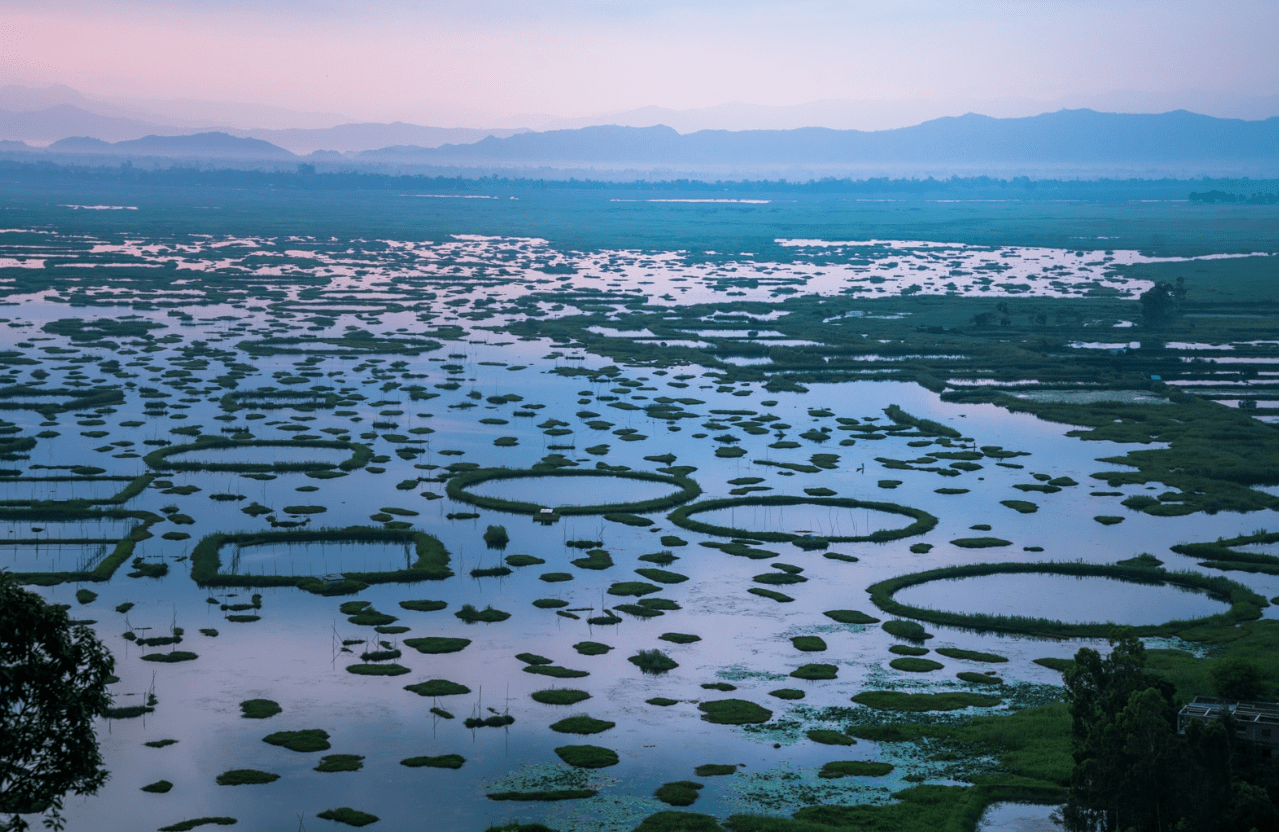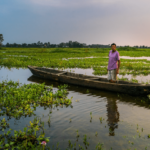During our flight to Imphal, we glimpsed vast blue stretches interspersed with green, ring-like formations—our first view of Loktak Lake in Manipur. At that time, however, our journey was bound for Myanmar, crossing the Moreh-Tamu border, leaving us no chance to explore the lake and its floating islands. It wasn’t until later, when we revisited Manipur, that we were able to include this unique destination in our itinerary.
The Phumdis of Loktak Lake
Loktak Lake, located in Manipur, Northeast India, is a breathtaking destination that will captivate you with both its stunning visuals and intriguing facts. Known as the largest freshwater lake in Northeast India, its floating islands, or Phumdis, add to its charm. This lake, often referred to as the “Jewel of India,” impressed us as much as Dal Lake, leaving a lasting memory.
Our visit to Manipur took place at the end of January. After enjoying two sunny days in Imphal, the weather turned gloomy as we set out for Moirang. By the time we reached Bishnupur, the sun was shining again, reminding us of the unpredictable weather in Northeast India.
In Bishnupur, we made a brief stop to explore some historic temples—a topic for another blog post. After a 40-minute drive, we arrived in Moirang, where we intended to visit the INA memorial. Unfortunately, it was closed for the day.
Our homestay host met us in Moirang and guided us to the lakeside, where we boarded a boat to our floating homestay on Loktak Lake. Built on the Phumdis, the homestay was charmingly simple and elegant.
Journey to Loktak Aquamarine Homestay
We boarded a narrow boat with our luggage, navigating through the swamps and floating vegetation of Loktak Lake. After a delightful boat ride, we arrived at our floating homestay.
Loktak Aquamarine Homestay
Our stay at the Loktak Aquamarine Homestay was exceptional. Constructed from bamboo, it features three cottages situated on Phumdis. The homestay includes a kitchen and dining area. We were shown our cottage and given the option to choose between the ground floor or the first floor. We enjoyed delicious rice and fish for lunch and local dishes for dinner.
Breakfast with a View at Our Homestay
The homestay offered a serene escape from the outside world. With no noise and complete tranquility, it was the perfect place to relax. We spent our time sitting in front of the cottage, watching the ripples on the lake, the Phumdis, and the fishermen at work.
What are Phumdis?
Phumdis are floating masses of vegetation, soil, and organic matter that grow from the bottom of Loktak Lake. They can vary in size, with some covering up to 50 square kilometers. The Sendra Tourist Lodge is situated on one of these large Phumdis.
Phumsangs or Floating Huts
Locals build floating huts, or Phumsangs, on the Phumdis for fishing. They select non-squishy Phumdis, cut them to size, and bind them with strong threads and ropes. Bamboo layers are added for stability. Anchored with heavy stones, these Phumsangs are a labor-intensive but vital part of local life.
The Rings of Loktak
The rings you see on the lake are man-made aquaculture structures called Athaphums. Created by cutting Phumdis into smaller pieces and arranging them in circles, these rings help gather fish. The fishing technique using Athaphums has been a tradition among the locals for generations.
Challenges Facing Loktak Lake
Loktak Lake, covering 230 square kilometers, was once farmland and grazing land. The construction of the Ithai Barrage in 1979 submerged about 20,000 hectares of arable land, with unofficial estimates reaching 80,000 hectares. The lake’s depth has decreased significantly over the years, affecting its ecosystem and fish population.
Government Actions for Loktak Lake
Efforts to address the lake’s issues include a major cleanup by the Loktak Development Authority in 2011, which involved clearing Phumdis and destroying several huts. This effort displaced many families, and while compensation was provided, it was not sufficient to fully address their needs. The lake is now divided into a no-development zone and a conservation zone.
Can Tourism Save Loktak Lake?
Tourism at Loktak Lake is still in its early stages. While it has the potential to benefit locals through homestays and tours, the infrastructure is not yet prepared for large numbers of visitors. Responsible tourism, with careful planning and gradual development, could support the lake and its residents.
What to Do at Loktak Lake
1. Keibul Lamjao National Park
- The only floating national park in the world, Keibul Lamjao is home to the endangered Sangai deer. Boat rides at dawn offer the best chance to see these elusive creatures.
2. Visit the Loktak Lake Viewpoint
- A hilltop viewpoint with a watchtower provides panoramic views of the lake and is an excellent spot to watch the sunrise.
3. Take a Morning Boat Ride
- An early morning boat ride offers a chance to experience local life on the lake, with encounters with fishermen and picturesque scenery.
4. Explore the Local Islands – Sendra and Karang
- Visit islands like Sendra Island, which has a tourist lodge and a small garden, and Karang Island, accessible by local boat.
5. Watch the Sunset
- Enjoy a sunset over the lake from a hill or a boat, though be mindful that sunsets typically begin around 4 PM.
Our Time at Loktak Lake
Our stay at the homestay was a memorable and peaceful experience. We enjoyed a morning boat ride, visited Sendra Island and the Loktak Viewpoint, and extended our stay to fully appreciate the lake’s tranquility. We also explored Churachandpur, another offbeat destination in Manipur.
Loktak Lake Travel Guide (FAQs Answered)
How to Reach Loktak Lake?
- Start from Imphal and take a shared taxi to Moirang. From there, take another shared taxi to Thanga. You can also arrange a pickup with your homestay owner.
Where to Stay at Loktak Lake?
- Options include homestays on the lake like Loktak Aquamarine Homestay, and accommodations on Sendra Island.
How to Be a Responsible Tourist at Loktak Lake?
- Limit single-use plastics, opt for local homestays, avoid processed foods, use traditional boats, and engage with locals respectfully.


